Kubsat who survived
On a cool evening of October 28, 2014, the Antares launch vehicle smoothly detached from the launch pad. According to the plan, she was to deliver to the ISS a private transport ship Cygnus and a couple of dozen research kubsat. Unfortunately, this autumn evening turned out to be extremely hot: fifteen seconds after launch, an explosion occurred in the region of the missile's main engines.

Later, the commission will determine that the cause of the accident was the destruction of the turbopump assembly of the first engine, which led to an explosion and damage to the second engine. The lost rocket with full fuel tanks crashed onto the launch pad. The wreckage of what was a promising transport ship a minute ago was now spreading along the Atlantic coast.

The fire on the ground lasted more than an hour and permanently disabled the launch complex. The consequences were also for Orbital ATK: the next Cygnus was able to be launched only after a year, and Atlas-5 had to be used as a carrier. The Antares rocket was even less fortunate: the long-suffering AJ-26 engines (and they still had enough problems with the tests) were decided to be replaced with the more modern RD-181, because of which the flights had to be postponed for almost two years.

But every cloud has a silver lining. Among the debris found on the coast, it was possible to find practically intact one of the cubs - GomX-2. Despite its small size, one of the objectives of this satellite was very adventurous: pave the way into space for quantum cryptography. The developers (a research team from Singapore) wanted to check whether the source of entangled photons in the space is real. The experiment was supposed to be pioneering, so sending entangled photons to Earth or to other satellites was not supposed. Nevertheless, the device was not simple: the satellite installed:
- source of entangled photons;
- a circuit for measuring the degree of entanglement (using avalanche photodiodes);
- high voltage source for photodiodes;
- thermal stabilization system of all optics;
- Finally, not the easiest electronics to control all this.
And all this - on a board measuring 10 by 10 centimeters and weighing only 250 grams!

The fact that such a stuffed satellite managed to survive the rocket explosion is like a miracle. Apparently, three factors played a role in this. First of all, the rocket fell on the launching table almost vertically, so the payload managed to avoid the fire - it threw it and threw it to the sides with a blast wave. This confirms the fact that the collars on the found satellite remained intact, which should have melted already at 144 ° .
The second reason is that all Cubsat planned to launch from the ISS. This is done with the help of such a launcher:

The launcher is charged manually inside the ISS, and for this reason all the Cubs were inside the cargo ship. Apparently, the Cygnus corps played a saving role for the satellites - just like a cooler for Indiana Jones trying to escape from a nuclear explosion.

Finally, the developers of the satellite responsibly approached the mount optics. Each element was located in a small recess, carved into a single piece of aluminum, and poured with epoxy resin.
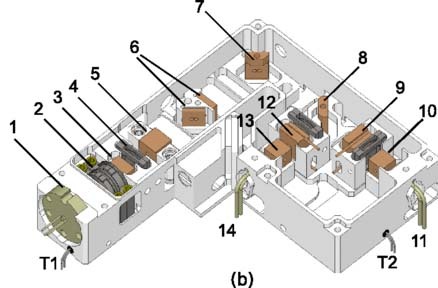
Some optical elements were very sensitive to turns, and they had to be installed a bit more cunning. At first they were fixed on a micrometric table and adjusted, then poured with epoxy. When it was completely frozen, the adjustment table was removed.

Optics
The main use of the source of entangled photons is the quantum key distribution according to the Ekert protocol (the details are under the spoiler). Let's see how it works on the satellite.
The essence of the Eckert protocol is as follows: the source generates pairs of photons, one of which is sent to Alice, the second to Bob. The photons in a pair are polarized entangled: their polarizations coincide, but which ones they are, we do not know.
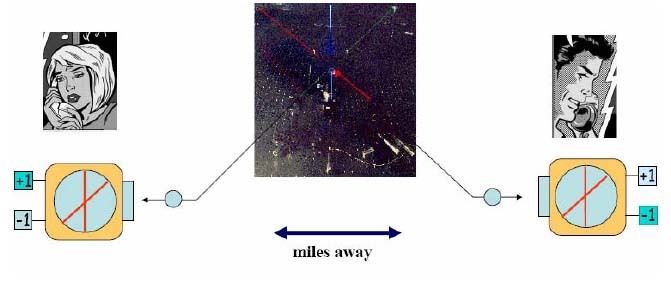
Alice and Bob have a polarizer that transmits photons vertically polarized and reflects horizontally polarized (in its frame of reference). It can be installed in one of three pre-selected positions. Actually, Alice and Bob are exactly this whole movie and do: for each incoming photon, they accidentally set the polarizer in one of three positions. And after the set of photons they call each other and tell each other how the polarizer was set for each of the photons.
If the polarizers were installed in the same way, then the entangled photons will behave in the same way (either they will pass through the polarizer or they will be reflected). How the photons behaved is known to both Alice and Bob - and no one else. Therefore, these results can be used as bits of the secret key.
Why then rotate the polarizers? The fact is that their different positions allow Alice and Bob to check Bell's inequalities (they are known to be violated in our quantum world). But if Eve appears in the communication channel and starts reading or replacing photons, then there will be no trace of entanglement, and Bell's inequalities will be fulfilled. This will be a sign that the communication channel has been compromised.
Pairs of entangled photons are usually produced in a spontaneous parametric process, where one photon splits into two with half the energy (and, accordingly, twice as long wavelength) and entanglement in one of the parameters (for example, polarization). This happens in tricky non-linear crystals and looks like this (pairs of photons are shown in green):
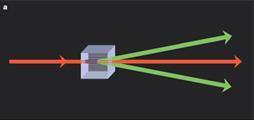
In the picture, a pair of photons fly apart in different directions, but it can spread along the main beam. Generally speaking, the probability of generating a pair is small. But this is not a bug, but a feature: pairs of photons are not generated very often and do not mix with each other; There are no problems in the spirit of "what pair of this photon is it from?" Now let's see what the optics on GomX-2 looks like:
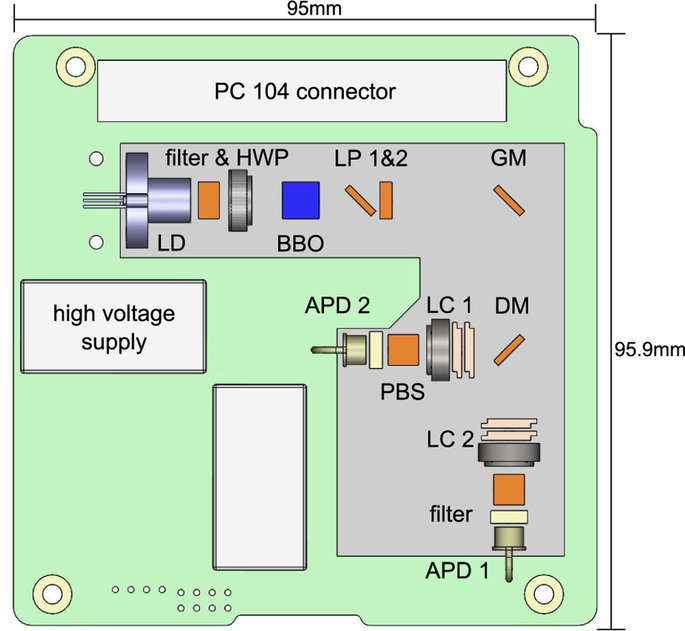
Here, an LD laser diode with a wavelength of 405 nm (violet) generates photon pairs in a BBO crystal (β-barium borate). The photons in a pair are obtained with different wavelengths - 760 and 867 nm, but this does not affect entanglement. Immediately after this, the color filters LP 1 & 2 remove the illumination from the violet laser, and the GM mirror turns the pair of photons down towards the detectors.
The next part is the measurement of entanglement. In essence, it is a test of whether the polarizations of the photons coincide with different orientations of polarizers. On the optical scheme, this is the lower part: the DM mirror reflects one photon and passes the other; after that, each of the photons hits the rotating polarizer LC-PBS, and then the avalanche photodiode APD.
The essence of the experiment is that for different orientations of polarizers the number of coincidences is considered - that is, events when two photodiodes are simultaneously detected by a photon. It should be maximal when the polarizers are rotated at the same angle, and minimal when they are perpendicular to each other. Several programs of experiments were recorded in the Kubsat microcontroller, each lasting half an hour. It didn’t work any longer: the satellite heats up to +26 on the Sun; the experiment was planned at +18.
A couple of words about the polarizer. In fact, it does not rotate: its polarization is changed by applying voltage to the LC plate LC. This plate suffered the most at the explosion: not only is it fragile, so also irreversible damage occurs in it already at 90 ° C. The graph shows that the accuracy of the change in polarization went away after the explosion (blue curve):
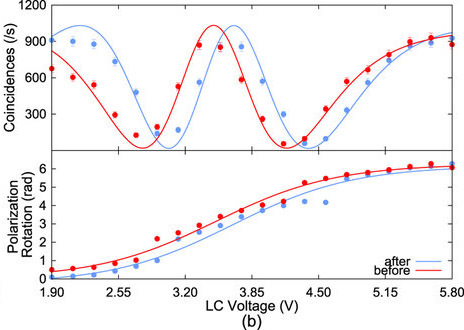
At the same time, the source itself survived the accident quite cheerfully - the correlations remained at a high level. Instead of the world's first cosmic source of entangled photons, the world's first source has emerged that can compete with Indiana Jones.

Epilogue
It is a pity that GomX-2 could not fulfill its mission. On the other hand, then the designers would not be able to get the most valuable experience, to ensure the highest reliability of their offspring and to achieve another launch attempt. The second flight copy went into space in December 2015 at the first Singaporean cubsate GALASSIA .

The experiment began in late January. All this time, the temperature regime of the Kubsat remained normal, and the photodiodes, laser and LCD polarizers have not lost their properties. Finally, the most important thing: the source really generated entangled photons. The first cosmic experiment in quantum optics ended in phenomenal success.

During this time, the launch pad was repaired at the MARS cosmodrome. Now tests of Antares rocket with new engines are ending. Its next launch is planned very soon - this September. We wish her a happy flight.
')
Source: https://habr.com/ru/post/372583/
All Articles